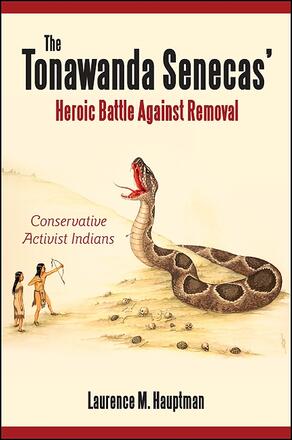
The Tonawanda Senecas' Heroic Battle Against Removal
Conservative Activist Indians
Alternative formats available from:
The definitive eighteenth- and nineteenth-century history of the Tonawanda Senecas of western New York State.
Description
The remarkable story of the Tonawanda Senecas in the face of overwhelming odds is the centerpiece of this landmark community study. In the six decades prior to the Civil War, they wrestled with pressures from land companies; the local, state, and federal officials' policies to acquire tribal lands and remove the Indians; misguided Quakers who believed they knew what was best for the Indians; and divisions among Seneca communities about what strategies of resistance to employ. As deftly and convincingly revealed by Laurence M. Hauptman, the Tonawanda Senecas were able strategists who overcame disastrous treaties to regain 7,549 acres of their western New York territory, lands that they still possess today.
The chiefs and clan mothers pursued a number of well thought-out strategies: petitioning officials and lobbying in Washington, challenging the legality of the treaties; preventing surveyors from entering onto tribal lands; disrupting land auctions; taking out advertisements; and networking with influential whites. They also hired a first-rate attorney who eventually won a landmark victory in the U. S. Supreme Court and who successfully negotiated the United States–Tonawanda Treaty of 1857, which provided a formula to repurchase a part of the reservation. In recounting this heroic story, Hauptman throws new light on Red Jacket and Ely S. Parker, women's roles within Tonawanda society, and the development of the Gaiwiio, the Longhouse religion.
Laurence M. Hauptman is SUNY Distinguished Professor of History at SUNY New Paltz. His many books include Seven Generations of Iroquois Leadership: The Six Nations since 1800; A Nation within a Nation: Voices of the Oneidas in Wisconsin; and Formulating American Indian Policy in New York State, 1970–1986, also published by SUNY Press.
Reviews
"…delivers a compelling account of the Tonawanda Band of Senecas' struggle with the white man, dispelling the notion that Native Americans were naïve victims 'in the inevitable march of westward expansion. ' … Hauptman's style is engaging and cogent as he follows the trail of lawsuits, offers and counteroffers between the Tonawandas and the governments of New York State and Washington. " — Western New York Heritage
"In this brief, accessible volume, prolific historian Hauptman details the successful 19th-century struggle of the Tonawanda Band of Seneca Indians to secure their territory in western New York State and protect themselves from federally sponsored removal … An important study in the history of Indian sovereignty that deserves broad readership … Highly recommended. " — CHOICE
"The little known saga of the traditionalist Seneca community at Tonawanda is told here in admirable style and with impeccable scholarship. " — Anthony F. C. Wallace